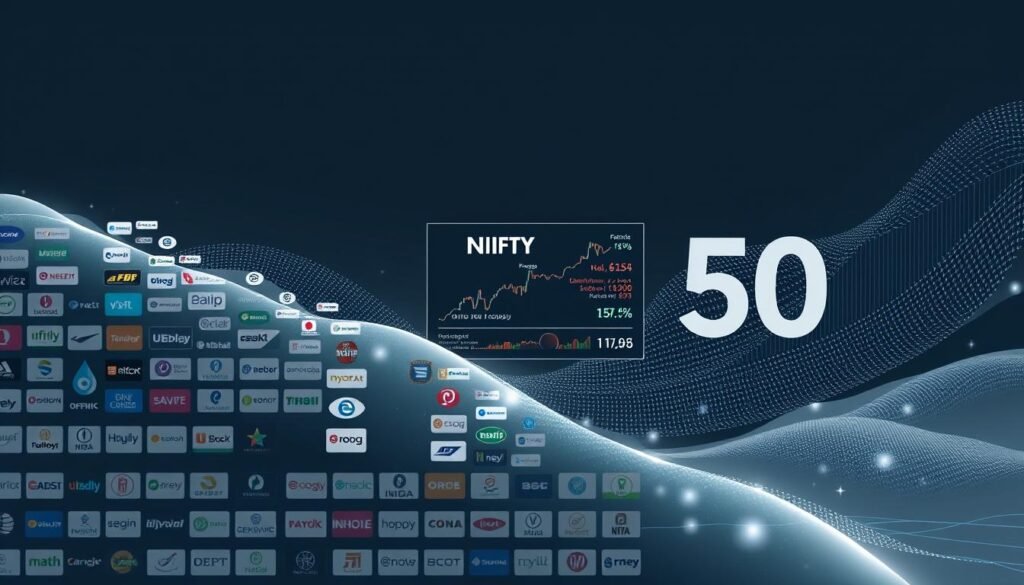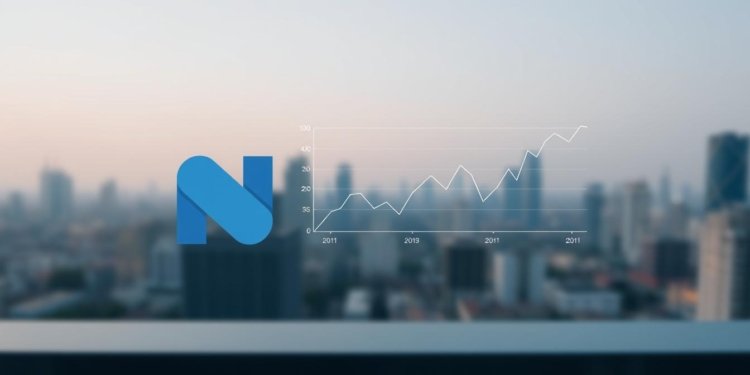Did you know that India’s stock market index, tracking 50 top companies, has grown over 2,000% since its launch in 1996? The Nifty 50 serves as a powerful indicator of economic health, much like the S&P 500 does for the U.S. market.
This benchmark index covers diverse sectors, with financial services making up nearly 33% of its weight. Managed by the National Stock Exchange, it helps investors gauge market trends through its free-float methodology.
Comparing global indices reveals how emerging markets like India offer unique growth opportunities. The Nifty index provides a snapshot of Asia’s third-largest economy, reflecting shifts across 13 key industries.
Key Takeaways
- Tracks 50 major companies on India’s National Stock Exchange
- Uses free-float market capitalization weighting
- Financial services dominate sector representation
- Serves as primary indicator of Indian economic trends
- Comparable to S&P 500 for U.S. market analysis
Introduction to Nifty: India’s Premier Stock Market Index
India’s stock exchange india offers a dynamic gateway for global investors through its premier index. Owned by NSE Indices, it tracks 50 top-performing stocks, reflecting the nation’s economic pulse.
The indian stock market relies on this benchmark for liquidity and trend analysis. Foreign investors use it to access India’s growth story, with derivatives and index funds worth $7.8T tied to its performance.
Current companies listed represent 65% of the NSE’s free-float market cap. Unlike Sensex, it covers more sectors and constituents, offering a broader market snapshot.
Globally, GIFT Nifty enables round-the-clock trading in Dubai and Singapore. This cements its role as Asia’s financial powerhouse.
The History of Nifty: From Inception to Today
April 1996 marked a pivotal moment for India’s financial markets with the launch of a groundbreaking index. Starting with a base value of 1,000 points, it introduced a new way to track the nation’s economic health. This benchmark would grow to become Asia’s most watched financial indicator.
The index’s journey reflects India’s economic evolution through major global events. From the dot-com bubble to recent pandemic shocks, its resilience has been tested repeatedly. Each challenge brought refinements to its methodology and broader adoption.
Key Milestones in the Index’s Journey
2009 saw a critical shift to free-float market capitalization weighting. This change improved accuracy by focusing on publicly available shares. It better reflected true market dynamics for investors.
By 2017, the index crossed 10,000 points for the first time. This milestone confirmed India’s position among the world’s fastest-growing economies. The achievement came despite global trade tensions that year.
COVID-19 created unprecedented volatility in 2020. A single-day drop of 12.98% tested investor confidence. Yet recovery came faster than most analysts predicted.
September 2024 set new records as the index surpassed 26,000 points. This growth occurred during national elections, proving its stability. The current peak of 26,216 points shows continued strength.
Through crises like the 2008 crash (-51.79%) and pandemic shocks, the index has demonstrated remarkable resilience. Its performance serves as both a mirror and compass for India’s economy. Today, it stands as a trusted gauge for domestic and international investors alike.
What Are Nifty 50 Companies?
Comprising 50 elite stocks, this index mirrors India’s most influential business sectors. These companies represent 65% of the National Stock Exchange’s free-float market cap, selected through rigorous liquidity and impact cost evaluations.
To qualify, stocks must have six months of trading history with ₹100M average daily turnover. Recent additions like Jio Financial Services (2025) reflect India’s evolving economic landscape. Quarterly reviews ensure only the most liquid stocks remain.
Sectoral Weightage in Nifty 50
Financial services dominate with 32.76% exposure, led by HDFC Bank and ICICI Bank. Information technology follows at 13.76%, doubling its share since 2015. The oil gas sector, anchored by Reliance Industries, holds 12.12% weight.
Consumer goods (8.46%) and automotive (8.22%) complete the top five sectors. This distribution offers investors balanced access to India’s growth drivers. Sector rotations occur organically as market caps shift.
How Is Nifty Calculated?
Free-float market capitalization forms the backbone of this influential stock index. The calculation methodology weights companies based on shares available for public trading, excluding locked-in holdings. This approach gives a truer picture of market movements than full market cap calculations.
Foundations of Index Valuation
November 3, 1995 serves as the base year, with a starting value of 1,000 points and ₹2.06 trillion base capital. The index updates every 15 seconds using live trading data from the National Stock Exchange. Semi-annual rebalancing ensures constituents meet strict liquidity standards.
Stocks must maintain a 0.50% impact cost threshold, meaning large trades shouldn’t distort price significantly. Corporate actions like stock splits trigger automatic adjustments to maintain continuity. The system mirrors S&P 500’s approach but uses India-specific liquidity filters.
Real-time computation considers each company’s free-float market capitalisation relative to the base period. This dynamic method captures India’s rapidly evolving economic landscape while providing stability for derivatives pricing.
Why Nifty Matters to Investors
Daily trading volumes exceeding $50B highlight its significance for global investors. This index serves as the backbone for 83% of Indian ETFs, offering unmatched liquidity and transparency.
Active mutual funds use it as a benchmark—97% compare performance against its returns. Its free-float methodology ensures accurate reflections of market movements, critical for portfolio adjustments.
Derivatives tied to this index rank as the world’s second-most traded options. Contracts average 7.4M daily, providing hedging opportunities for institutional traders.
GIFT Nifty extends access across time zones, linking Dubai and Singapore markets. This global reach helps investment firms manage exposure to India’s growth story.
Sector weights guide asset allocation, with financials (32.76%) and IT (13.76%) leading. Historical data shows it predicts economic trends six months ahead, aiding strategic decisions.
Nifty 50 Constituents: Who’s In and Who’s Out
Quarterly reviews determine which companies earn a spot in this prestigious market indicator. The selection process evaluates financial health, liquidity, and sector representation to maintain the index’s relevance.

Evolving Composition of the Benchmark
The 2025 reshuffle saw Jio Financial Services and Eternal make their debut, replacing Britannia Industries and BPCL. These changes reflect shifting investor confidence in India’s financial and energy sectors.
Earlier in 2024, UPL and Divi’s Laboratories exited the index after failing to meet performance thresholds. New entrants must clear a $15B market cap hurdle and demonstrate six months of stable trading volumes.
Sector balancing remains a priority, with financial services gradually reduced from 35% to 32.76% weightage. This adjustment prevents overexposure while maintaining the index’s representation of India’s economic drivers.
Adani Enterprises’ controversial 2022 inclusion demonstrated the index’s focus on market capitalization over corporate governance concerns. The HDFC merger in 2023 significantly altered banking sector weights, showcasing how corporate actions impact indices.
Analysts monitor these changes closely as they signal emerging trends in Asia’s third-largest economy. The current 50 constituents represent the most liquid stocks across 13 key industries.
Major Single-Day Gains and Falls in Nifty
Market history reveals dramatic moments when this benchmark index experienced seismic shifts in a single trading session. These events highlight how quickly market sentiment can change during economic crises or political uncertainty.
Pandemic-Induced Market Turmoil
March 2020 saw unprecedented volatility, with circuit breakers triggering four times. On March 23, the index plunged 12.98% – its worst single-day drop in history. This reflected global panic as COVID-19 spread worldwide.
The recovery proved equally remarkable. From March lows to December 2020, the index surged 76%. This rebound outpaced most emerging markets, showing India’s economic resilience.
Recent history includes the June 2024 election shock, when a 5.93% drop occurred amid coalition government uncertainty. Such events demonstrate how political developments impact market performance.
Circuit breakers activate at 10% and 15% movement levels, pausing trade for 45 minutes. These safeguards prevent panic selling while allowing information absorption. The system has proven effective during extreme volatility.
Compared to peers, India’s index shows 18% higher volatility than China’s CSI 300 but remains more stable than Brazil’s Bovespa. This balance attracts global investors seeking growth with managed risk.
Annual Returns of Nifty: A Performance Review
Year-over-year returns reveal compelling patterns in India’s premier stock benchmark. The index has delivered a 10.2% compound annual growth rate since 2000, outpacing many global indices. This long-term value creation makes it a cornerstone for emerging market portfolios.
The 2008 financial crisis saw the sharpest drop at -51.79%, testing investor confidence. Contrast this with 2021’s robust 24.12% rebound post-pandemic. Year-to-date 2024 shows steady 8.80% growth despite global headwinds.
Dividend-adjusted returns tell a richer story than price movements alone. Reinvested payouts have added 2.3% annually to total returns since 1996. This often-overlooked factor significantly boosts long-term investment outcomes.
Decade comparisons show distinct performance eras. The 2000s averaged 8.4% yearly gains, while the 2010s jumped to 12.1%. Current decade trends suggest similar growth potential despite rupee depreciation affecting dollar returns.
Analysts use the Gordon Equation to project future returns, factoring in dividend yields and earnings growth. Current models suggest 9-11% annualized returns through 2030, assuming stable economic conditions.
Nifty Derivatives: Futures and Options
Round-the-clock trading through GIFT Nifty bridges Asian and European markets. This system enables 21-hour access to India’s premier index, with $6B daily volume flowing through international exchanges.
Derivatives traders utilize two primary instruments. Futures contracts carry a 75x multiplier with $15-20 margin requirements. Options provide flexibility through weekly and monthly expirations.

Global Access Through Specialized Contracts
The GIFT City platform offers tax advantages for foreign institutional investors. These account for 60% of derivatives volume. Traders exploit arbitrage between GIFT and NSE prices during overlapping hours.
Weekly options show 40% higher liquidity than monthly contracts. This suits short-term strategies. The 75x multiplier amplifies both gains and losses, requiring careful risk management.
Compared to other global indices, India’s derivatives market shows unique characteristics. The extended trading window captures volatility across time zones. This creates opportunities absent in traditional exchange hours.
Nifty Next 50: The Rising Stars
Beyond the top 50 lies a dynamic group of high-potential stocks. The nifty next index has delivered 18% annual growth since 2010, outperforming its larger counterpart by 4 percentage points.
Inclusion requires ranking 51-100 by market capitalization. These companies maintain strong liquidity with average daily trades exceeding ₹500 million.
Sector weights differ significantly from the main index. Consumer services hold 18% exposure, nearly double their representation in the top 50. This reflects emerging consumption trends.
Historical data shows 3-5 stocks graduate annually to the premier index. The promotion rate indicates which sectors gain market importance over time.
Higher volatility (22% vs 18%) attracts growth-focused investors. ICICI Prudential offers dedicated ETFs for those seeking diversified stocks in this category.
Conclusion: The Future of Nifty
The index is poised for transformative growth, with analysts projecting 30,000 points by 2026. An ESG-focused version launching in 2025 will cater to sustainability-minded investors, reflecting global trends.
AI-driven rebalancing will enhance accuracy, while extended European trading hours expand global access. The potential carbon-neutral market initiative aligns with climate-conscious investing.
Challenges remain in balancing retail participation with institutional flows. Yet, the long-term outlook stays bright—aiming for a $10T stocks market cap by 2030.
Today, the index stands as a gateway to India’s economic ascent, blending innovation with stability for forward-looking portfolios.
FAQ
What is the Nifty index?
The Nifty is India’s leading stock market index, representing the performance of 50 large companies listed on the National Stock Exchange (NSE). It serves as a benchmark for investors.
How is the Nifty calculated?
The index uses a free-float market capitalization-weighted method. It considers the base year (1995) with a base value of 1,000, adjusting for changes in stock prices and market capitalizations.
What sectors dominate the Nifty 50?
Financial services, IT, and oil & gas hold significant weight. Companies like Reliance Industries and HDFC Bank heavily influence the index due to their large market caps.
Why should investors track the Nifty?
It reflects India’s economic health and helps gauge market trends. Many mutual funds and ETFs align their portfolios with Nifty’s performance.
What is GIFT Nifty?
Formerly called SGX Nifty, it allows international trading of Nifty futures and options on the Gujarat International Finance Tec-City (GIFT) exchange.
How often are Nifty 50 constituents reviewed?
The index is rebalanced semi-annually (March and September). Companies are added or removed based on liquidity, market cap, and sector representation.
What was Nifty’s worst single-day drop?
On March 23, 2020, it plunged 12.98% due to COVID-19 fears. This remains its steepest fall in history.
How does Nifty Next 50 differ from Nifty 50?
Nifty Next 50 includes the 51st to 100th largest companies by market cap. These firms are potential candidates for promotion to the main index.












